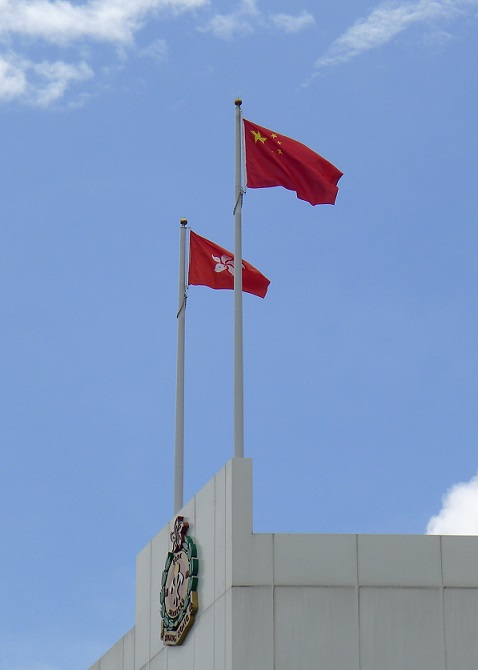藝評
Flags Flying Over Hong Kong
約翰百德 (John BATTEN)
at 4:52pm on 16th September 2014


Captions:
1. Flags, Aberdeen Fire Station, Aberdeen, Hong Kong.
2. Flags and security cameras, Aberdeen Police Station, Aberdeen, Hong Kong.
3. Flags, near Star Ferry Pier, Tsim Sha Tsui, Kowloon, Hong Kong.
4. Flag outside the Liaison Office of the Central People's Government in the Hong Kong Special Administrative Region, Sai Ying Pun, Hong Kong.
All photographs: John Batten.
(中文翻譯請往下看 Please scroll down to read the Chinese translation.)
After the riots of 1967, Hong Kong’s British administrators flew their flag much less often. Provocative for some, but legal at the time, hundreds of Taiwanese flags would line the length of Hennessy Road in celebration of the Double Tenth; that was, until 1997. Their appearance is furtive now. The Union Jack – the British flag – was also, prior to 1997, on the fuselage of each Cathay Pacific aircraft. It was a reminder that ‘Hong Kong’s airline’ was actually British-owned. It still is and now the flag’s absence from the company’s fleet of aircraft is a political concession, for a Hong Kong-domiciled, British airline in a place of Chinese sovereignty.
David Clarke*, fine arts teacher at Hong Kong University and artist, in his Experiencing Transition video highlights a moment when Hong Kong’s sovereignty hovered briefly between the United Kingdom and the People’s Republic of China at the British Crown Colony’s handover ceremony in 1997. The pause between one flag lowered and the other to be raised is, Clarke believes, “…a special in-between time of imaginary independence when Hong Kong was without signs of sovereignty….”
And now flags are really flying over Hong Kong. The decision for the placement, the showing, the flying of a flag – or not – is an unequivocal power statement. It’s about sovereignty.
Flagpoles are an architectural feature that architects rarely need to install on buildings. However, as I write, Hong Kong is having an official construction spree of flagpole installation on government buildings. Pairs of flagpoles, one slightly stooped beneath the other, each regally topped with bright gold anodized gold balls, are appearing on Hong Kong’s most prominent community facilities: fire and police stations - and other government-run buildings.
I associate flags with borders, legislatures, national or extra-territorial places and institutions. On residential buildings, a flag generally announces the occupant’s national pride or its extreme, nationalism. I suspect the latter is the motivation for Hong Kong’s flag-poling surge.
It is, at this time of debates about HKSAR Chief Executive and legislative electoral reform, a delicate matter. I can’t see, in this climate, officials’ enthusiasm for flags to be: flagged.
* See David Clarke’s Experiencing Transition: www.youtube.com/watch?v=Xg7v47L-H00&
國、旗。
自六七暴動以後,港英政府便不再經常高懸自己的旗幟。而在九七前的雙十節,整條軒尼詩道往往都會掛上數以百計的中華民國國旗;這雖然並不違法,卻難免觸動某些人的神經。九七之後,這些旗幟只能偷偷現身。同樣地,國泰航空在九七之前,都會於每架客機的機身飾上英國國旗,以示「香港的航空公司」實為英資公司。雖然國泰現時英資依舊,旗下機隊的英國國旗卻不復見;透過政治讓步,這間英國航空公司方可繼續在中國境內扎根。
在香港大學教授藝術的藝術家祈大衛(David Clarke)便在他所拍的《Experiencing Transition》一片,紀錄了1997年的主權交接儀式,更捕捉了香港主權徘徊中英之間的一剎。David認為,在米字旗落下、五星旗未懸之時,「⋯香港彷彿進入了特殊的獨立狀態,並不屬於任何一國。」
誠然,香港現時正在飄揚的國旗為數眾多,而國旗的位置、形態,甚至懸掛與否,都明確地象徵著權力。一切都關乎主權。
在香港政府主要的部門大樓,以及消防局或警局之類的社區設施上,全都設有一高一矮的旗桿,而桿頂總有閃閃生輝的金色圓球。
我通常將旗幟與國界、立法機關,以至國家或境外的地方和機構牽上關係。例如住宅上的旗幟通常都標誌了住戶對民族的認同感,甚或是其民族主義。我懷疑後者是香港現時國旗紛懸的主因。
在特首和立法會選舉改革討論正盛之際,民族認同會是微妙的話題。而在如此氣氛下,政府官員對國旗的激情沒有一點減退的跡象。
若要觀看 祈大衛(David Clarke)的《Experiencing Transition》,可登上www.youtube.com/watch?v=Xg7v47L-H00&。
This article was originally published in Perspective architectural magazine, September 2014.
